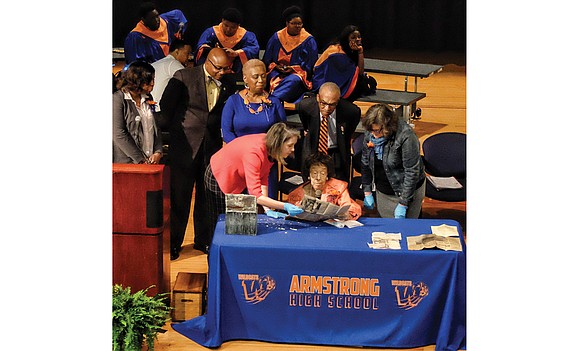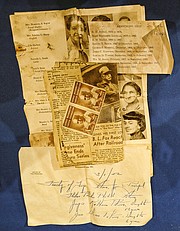Armstrong High time capsule takes alumni, students back in history
4/6/2018, 1:45 p.m.

By Saraya Wintersmith
Armstrong High School’s storied past collided with its present last Saturday as a legion of several hundred Wildcats, mostly from the Armstrong High School Alumni Coalition, gathered to witness the opening of a 1952 time capsule.
The time capsule — a bread box-sized, tarnished copper container — sat inside the foundation of the former Armstrong High School building on 31st Street in the East End until it was discovered recently when the building was demolished.
The alumni coalition, established to preserve and promote the history and legacy of the historic school, thought the capsule had been placed in 1951, when the former building was constructed. But during a lively ceremony on Saturday at the current Armstrong building on Cool Lane, the box’s contents made it clear that the capsule had been placed in 1952.
Excitement grew as a student from the Wildcats band struck a drum roll. The crowd broke into cheers as John Dorman, a 1966 alumnus, strode down the auditorium aisle, capsule in hand, toward the stage decked out in bursts of blue and orange, the school’s colors.
On stage, 89 year-old Armstrong alumna, retired educator and former Richmond Public Schools Superintendent Lucille M. Brown joyfully reminisced about the institution’s former teachers and students. She also told the crowd she recalled a time during segregation when Armstrong graduates were denied entry into all-white state colleges because of their race, and yet they prevailed in their various fields.
“They had not heard of Armstrong High School,” she declared with pride.
After her remarks, a gloved preservationist from The Valentine museum fished objects from the time capsule as Dr. Brown reviewed each and related stories.
Inside the metal container was a three-page history of Armstrong High School detailing its connection to some of the first schools for Negro children in Richmond in 1865 that were financed, in part, by the Freedman’s Bureau and constructed by the donated labor of African-American mechanics and laborers.
“This is precious — and valuable,” Dr. Brown exclaimed while peering at the document.
In 1909, the school was moved to First and Leigh streets and named in honor of the founder of Hampton Institute, Union Gen. Samuel C. Armstrong. The school relocated again in 1923 and again in 1951 before merging with the former Kennedy High School on Cool Lane in 2004, but continuing to use the Armstrong name, mascot and colors.
For decades as Virginia maintained a system of racially segregated schools, Armstrong was one of only two high schools in Richmond dedicated to the education of African-American students. The other school, Maggie L. Walker High School, was Armstrong’s biggest rival in sports.
Several copies of the student newspaper, “Spirit of Armstrong,” were folded in the time capsule, including a December 1947 edition detailing the Armstrong-Walker football game. “This victory meant a state football championship,” according to a Feb. 22, 1952, note penned by then-Principal George Peterson Jr.
Other items stashed in the capsule included a copy of the Book of Psalms and a book of biographies of presidents and secretaries of the National Negro Insurance Association from 1921 to 1949.
The box also contained copies of the Richmond Times-Dispatch newspaper, including one dated March 1, 1952. It contained an article describing closing arguments in the historic Prince Edward County school desegregation case inspired by 16-year-old student Barbara Johns.
The state, represented at the time by Attorney General J. Lindsay Almond Jr., argued that racial segregation was an issue of states’ rights, while Richmond attorneys Oliver W. Hill Sr. and Spottswood W. Robinson III argued Virginia’s segregated public education laws were unconstitutional.
The case eventually would be included with four others in the landmark 1954 U.S. Supreme Court decision Brown v. Board of Education outlawing segregation in public education nationwide as separate but unequal.
After the time capsule opening, the event turned into a reunion as alumni and students celebrated with blue and orange cupcakes and a fountain of orange soda.
“We are a family. We have always been a family,” said Ingrid Crump, Class of 1963, after the capsule’s opening. “I almost feel sorry for the kids coming up now because they don’t have the type of comradery with their peers once they get old,” she said, crediting part of the tight bond among Armstrong and Maggie Walker High School graduates to segregated schools.
“We’ve followed each other from elementary through high school, through college. And at 71, it’s magnificent,” she said.
Davantae Ballou, 18, a member of the Armstrong Class of 2018, called the event inspiring. He said it’s important for people to remember the school’s history.
“It makes me proud to be an African-American in a school that started out for African-Americans,” he said.
Dennis H. Harvey, Class of 1966 and chair of the alumni coalition, concluded the program with a tearful address that he said he hopes to share with younger Armstrong alumni and students.
“Never did I think I would be this age when I was in your seats,” the 70-year-old said, explaining that some students, upon seeing his picture in an Armstrong history exhibit, said he looked like “a civil rights person.”
“It really brought it home to me,” he said. “We are beneficiaries and participants in the Civil Rights Movement. 1951 was the year that Barbara Johns, in Farmville, led all of her students out of their school (in a walkout) because of the dilapidated conditions. Armstrong, our school, was built in 1951,” he continued, referencing the efforts of student Linda Brown of Topeka, Kan., whose family brought the landmark school desegregation case. Ms. Brown died on March 25 at age 75. He also talked about the deaths of 14-year-old Emmett Till, who was lynched in 1955 in Mississippi, and the death 50 years ago of Dr. Martin Luther King Jr.
“I want to remind you all that we were our ancestors’ wildest dreams,” he said. “And you are your ancestors’ wildest dreams, for sure.”







